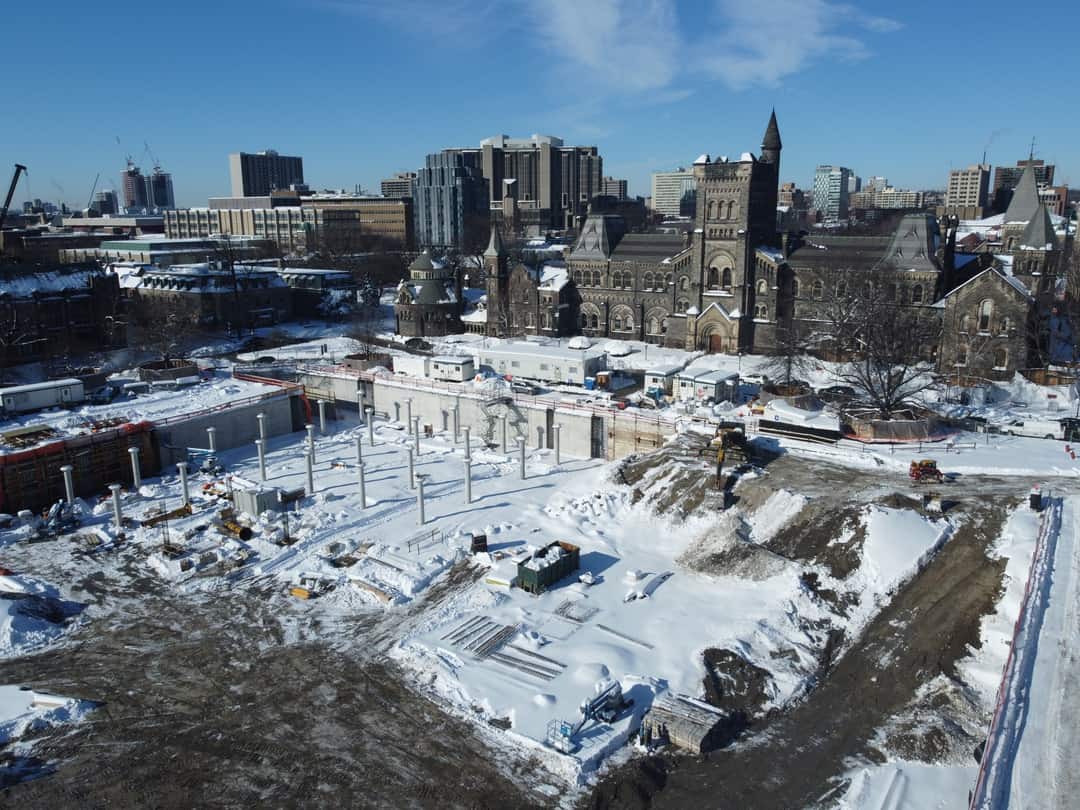The unsightly view of dump trucks and the sounds of aggressive drilling are not what most people associate with UTSG, yet they seem to have become prominent features on campus.
Out of the many construction projects at U of T, the most noticeable one can be found on King’s College Circle. The well-known and beloved Front Campus usually boasts incredible views of Convocation Hall and the CN Tower. Unfortunately, construction has made Front Campus and other spots on campus unattractive and louder than usual.
Despite the benefits these construction projects promise, many students are still confused about why places — in particular, their favourite graduation photo-op locations — are under construction. However, if you subtract the current inconveniences and noise from U of T’s construction projects, you are left with promising spaces for students to enjoy in the future.
A construction boom
For a majority of the COVID-19 pandemic, students have not been on campus. This has allowed construction crews to work freely on campus without having to interfere with students making their way to classes.
One of the main projects to commence while students were away was U of T’s Landmark Project. The project has many aims, including making campus more pedestrian-friendly and installing one of the largest geothermal fields in any Canadian city.
Other large construction projects at UTSG include the building of the 750,000-square-foot Schwartz Reisman Innovation Centre and the Fitzgerald Revitalization project, both found on College Street.
Although construction is most visible at UTSG, it has also been taking place at other U of T campuses. Construction is underway to build a new science building at UTM, while an instructional centre and nine-storey residence building are being constructed at UTSC.
A focus on accessibility
Construction has made it trickier for students to maneuver around and conveniently access parts of UTSG. However, once many of the construction projects are completed, there will be more accessible buildings and features available for students and staff.
For example, the Spadina-Sussex residence, which is currently under construction, will have more accessible rooms than any other residence building at UTSG. The Landmark Project will also bring many accessibility-friendly features once completed, such as textured paving around King’s College Circle for people with visual impairments, a new entry ramp to the Medical Science Building, and minimized curbs.
It may be difficult to picture these completed projects amid the current mess of construction. But a completed example of accessibility improvements can be found inside the newly renovated University College. More ramps and other accessibility-friendly features have been incorporated into the building. These help ensure that all students can easily access UC’s new and beautiful amenities such as the renovated library and reading room.
Through the example of UC, students can get a glimpse of the amazing accessible spaces that these construction projects will bring to U of T.
Benefits for the environment
Some of the construction projects on campus will also help reduce the university’s carbon footprint when completed.
The most notable component of making U of T more environmentally sustainable is the geo-exchange system being installed as a part of the Landmark Project. The system will be able to store excess heat and use it when the temperature drops. Once the geo-exchange system is installed, U of T is expected to save 15,000 metric tonnes of carbon per year. The Fitzgerald Revitalization project also intends to make the building meet U of T’s Design Standards for Energy Efficiency for New Construction, thereby minimizing energy usage.
It should be noted that some of the construction projects on campus have disrupted the environment rather than helping it. For example, the deep digging at Front Campus has disturbed a mini ecosystem. However, the pros outweigh the cons.
The geo-exchange system is not only reducing carbon emissions, but is a component of a plan that will hopefully make U of T carbon-neutral by 2050. Additionally, a parking garage that will be located under Front Campus will have more than 300 bike parking spaces and 60 electric vehicle parking spaces, thus reducing car congestion around King’s College Circle.
In addition, it is hoped that the mini-ecosystem that once existed at Front Campus will thrive again once the Landmark Project is completed, especially with the reduction of automobile impacts on the environment in that area.
Therefore, although the construction projects at UTSG may disrupt the environment temporarily, they will have an overall positive impact once construction is completed, both for the environment and for students and staff.
New amenities for current and future students
Completed construction will bring revolutionary spaces and amenities for students. The Fitzgerald building will have new spaces for video production on campus, while the Schwartz Reisman Innovation Campus will provide a plethora of spaces devoted to AI innovations and medicine.
Not only will these refurbished spaces be useful for students and staff, but they will also help further enhance the aesthetic appeal of campus. Front Campus will become a flourishing outdoor space for students to walk and rest, and the Schwartz Reisman Innovation Campus will feature vertical gardens and large, open entrance halls.
These construction projects on campus clearly possess the potential to create a better and more accessible university. Yet, it is understandable for students to be frustrated because of the construction, especially when many are confused about what exactly is being built or renovated. All students can do for now is hope for the projects to be completed soon so that they can reap the benefits that are being sown within these new spaces.
Thérèse Perucho is a third-year human geography, political science, and practical French student at University College. She serves as the Literary & Creative Arts Commissioner of the University College Literary and Athletic Society.


